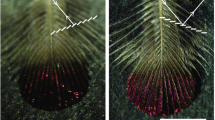Summary
The gas-filled iridescent melanin grains of Lamprotornis are formed by melanocytes in the feather germ. Parts of the Golgi field of these cells expand into bubbles with a diameter of 1 μ, which engulf smaller bubbles. Inside the large bubbles a particular material, consisting of lamellae in a zigzag arrangement, arises. During the following flattening process, the small bubbles get attached to this structure, thus forming the matrix of the premelanosoms. Along the surface of this matrix melanin is deposited up to thickness of 0,07 μ. By means of long dendrites the fully developped melanin grains are conveyed in the cytoplasm of the barbules by pinocytosis. In the course of the keratinisation the melanin is accumulated in a layer in between the cell membrane and the keratin fibrils. This results in the formation of the reflecting plane of the iridescent structure. Following the principle of “the colours of thin leaves”, the appearance of a specific interferential colour is dependent on the thickness of the melanin coating and the dimensions of the honeycomblike inner structure of the melanin grains.
Zusammenfassung
Die gasgefüllten schillernden Melaninkörner des Glanzstars (Lampro-tornis) werden in den Melanocyten des Federkeims gebildet. Teile des Golgi-Apparates erweitern sich zu 1 μ großen Blasen, in welche kleinere Bläschen eingeschleust werden. Im Innern der Blase bildet sich eine Zickzack-Lamellenstruktur, an die sich bei der folgenden Abflachung die Bläschen anlagern und so die Matrix des Praemelanosoms aufbauen. Darauf beginnt die Anlagerung des Melanins an die Matrix in bestimmter Dicke. Mit Hilfe von langen Ausläufern werden die fertigen Melaninkörner zu den Radienzellen befördert, in die sie pinocytoseartig eingeschleust werden. Bei der Verhornung erfolgt die Ordnung des Melanins zu einer Schicht zwischen Zellwand und Keratinfibrillen im Innern. So entsteht die reflektierende Ebene der Schillerstruktur, wobei Dicke des Melaninmantels sowie Größe der wabigen Innenstruktur nach dem Prinzip „Farben dünner Blättchen“ eine bestimmte Interferenz-Farbe erzeugen.
Similar content being viewed by others
Literatur
Billingham, R. E., and W. K. Silvers: The melanocytes of mammals, Quart. Rev. Biol. 35, 1–40 (1960).
Birbeck, M. S. C.: Electron microscopy of melanocytes. Brit. med. Bull. 18, 220–222 (1962).
Breathnach, A. S., and S. Poyntz: Electron microscopy of pigment cells in tail skin of Lacerta vivipara. J. Anat. (Lond.) 100, 549–569 (1966).
—, and L. Willie: Ultrastructur of retinal pigment epithelium of the human foetus. J. Ultrastruct. Res. 16, 584–597 (1966).
Durres, H.: Schillerfarben beim Pfau. Verh. Naturforsch. Ges. Basel 73, 204–224 (1962).
—: Bau und Bildung der Augfeder des Pfaus. Rev. suisse Zool. 72, 264–411 (1965).
—, u. W. Villiger: Schillerfarben der Nektarvögel. Rev. suisse Zool. 69, 801–814 (1962).
—: Schillerfarben der Trogoniden. J. Ornithol., Leipzig 107, 1–26 (1966).
Greenewalt, C. H., W. Brandt and D. D. Friel: The iridescent colors of hummingbird feathers. Proc. Amer. Soc. 104, 249–253 (1960).
Koecke, H. U.: Die Anwendung des Elektronenmikroskopes bei der Untersuchung entwicklungsphysiologischer Probleme. Zeiss Inform. 60, 47–51 (1966).
—, u. W. Schlittenhelm: Die Entwicklung der Schillerfärbung während des Federwachstums und die Einlagerung des Melanin-Pigmentes in die Federzellen bei der Stockente. Wilhelm Roux' Arch. Entwickl.-Mech. Org. 153, 283–331 (1961).
Lerche, W., u. K. G. Wulle: Über die Genese der Melaningranula in der embryonalen menschlichen Retina. Z. Zellforsch. 76, 452–457 (1967).
Portmann, A.: Die Tiergestalt. Basel: Friedrich Reinhardt 1948/60.
—: Die Vogelfeder als morphologisches Problem. Verh. Naturforsch. Ges. Basel. 74, 106–132 (1963).
Rutschke, E.: Die submikroskopische Struktur schillernder Federn von Entenvögeln. Z. Zellforsch. 73, 422–443 (1966).
Schmidt, W., u. H. Ruska: Über das schillernde Federmelanin bei Heliangelus und Lophophorus. Z. Zellforsch. 57, 1–36 (1962).
Seiji, M., T. B. Fitzpatrick, and M. S. C. Birbeck: The melanosome: A distinctiv subcellular particle of mammalian melanocytes and the site of melanogenesis. J. invest. Derm. 36, 243–252 (1961).
Zelickson, A. S., and J. F. Hartmann: The fine structure of melanocyte and melanin-granula. J. invest. Derm. 36, 23–27 (1961).
Author information
Authors and Affiliations
Additional information
Herrn Prof. Dr. A. Portmann zum 70. Geburtstag gewidmet.
Rights and permissions
About this article
Cite this article
Durrer, H., Villiger, W. Bildung der Schillerstruktur beim Glanzstar. Zeitschrift für Zellforschung 81, 445–456 (1967). https://doi.org/10.1007/BF00342767
Received:
Issue Date:
DOI: https://doi.org/10.1007/BF00342767



